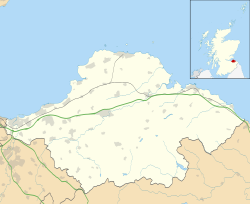
Back Ēast Loðene ANG لوثيان الشرقية Arabic East Lothian AST Източен Лоудиън Bulgarian Lodainn an Ear Breton East Lothian Catalan East Lothian CEB East Lothian Czech Dwyrain Lothian Welsh East Lothian Danish
East Lothian
Haddingtonshire | |
|---|---|
|
| |
 East Lothian shown within Scotland | |
| Coordinates: 55°55′N 2°45′W / 55.917°N 2.750°W | |
| Sovereign state | United Kingdom |
| Country | Scotland |
| Lieutenancy area | East Lothian |
| Unitary authority | 1 April 1996 |
| Administrative HQ | Haddington Town House |
| Government | |
| • Type | Council |
| • Body | East Lothian Council |
| • Control | No overall control |
| • MPs | 2 MPs |
| • MSPs | 2 MSPs |
| Area | |
| • Total | 262 sq mi (679 km2) |
| • Rank | 18th |
| Population (2022)[2] | |
| • Total | 112,450 |
| • Rank | 19th |
| • Density | 430/sq mi (166/km2) |
| Time zone | UTC+0 (GMT) |
| • Summer (DST) | UTC+1 (BST) |
| ISO 3166 code | GB-ELN |
| GSS code | S12000010 |
| Website | eastlothian |
East Lothian (/ˈloʊðiən/; Scots: Aest Lowden; Scottish Gaelic: Lodainn an Ear) is one of the 32 council areas of Scotland, as well as a historic county, registration county and lieutenancy area. The county was called Haddingtonshire until 1921.
In 1975, the historic county was incorporated for local government purposes into Lothian Region as East Lothian District, with some slight alterations of its boundaries. The Local Government etc. (Scotland) Act 1994 later created East Lothian as one of 32 modern council areas. East Lothian lies south of the Firth of Forth in the eastern central Lowlands of Scotland. It borders Edinburgh to the west, Midlothian to the south-west and the Scottish Borders to the south. Its administrative centre and former county town is Haddington while the largest town is Musselburgh.
Haddingtonshire has ancient origins and is named in a charter of 1139 as Hadintunschira[3] and in another of 1141 as Hadintunshire.[4] Three of the county's towns were designated as royal burghs: Haddington, Dunbar, and North Berwick.
As with the rest of Lothian, it formed part of the Anglo-Saxon kingdom of Bernicia and later the Kingdom of Northumbria. Popular legend suggests that it was at a battle between the Picts and Angles in the East Lothian village of Athelstaneford in 823 that the flag of Scotland was conceived. From the 10th century, Lothian transferred from the Kingdom of England to the authority of the monarchs of Scotland. It was a cross-point in battles between England and Scotland and later the site of a significant Jacobite victory against Government forces in the Battle of Prestonpans. In the 19th century, the county is mentioned in the Gazetteer for Scotland as chiefly agricultural, with farming, fishing and coal-mining forming significant parts of the local economy.
- ^ "Your council". East Lothian Council. Retrieved 7 September 2024.
- ^ a b "Mid-Year Population Estimates, UK, June 2022". Office for National Statistics. 26 March 2024. Retrieved 3 May 2024.
- ^ Charter by King David to the church of St. Andrews of the church of St. Mary at Haddington
- ^ Charter by King David granting Clerchetune to the church of St. Mary of Haddington

